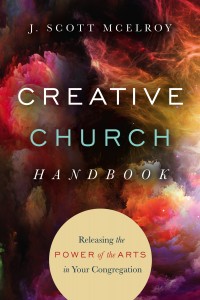 Welcome to the online extras and resources for Chapter 11: Live Art in the Church of The Creative Church Handbook. What you’ll find here is material that is helpful and important, but couldn’t be included in the book because of space constraints. Some thoughts include a reference to the specific page they would have appeared on.
Welcome to the online extras and resources for Chapter 11: Live Art in the Church of The Creative Church Handbook. What you’ll find here is material that is helpful and important, but couldn’t be included in the book because of space constraints. Some thoughts include a reference to the specific page they would have appeared on.
For information and discussion on similar topics see The New Renaissance Arts Movement site at TheNewR.org. For questions, comments, or use permissions you may contact the author directly at Scott (at) TheNewR.org.
Visit our CreativeChurchArtsIdeas.org website for more ideas for creativity and arts ministry in the local church!
This page is under construction. Check back for updates!
Chapter 11: Live Art in the Church
Random thoughts on live painting:
- Beginning platform painters or prophetic artists can be under the impression that research and image references somehow don’t belong in a spiritual painting practice, but there is nothing more spiritual about painting without preparation or references. It’s not cheating or less faith-filled. God may bless someone with an amazing gift of art making, but developing it will involve practice, training and research, just like any other skill.
-
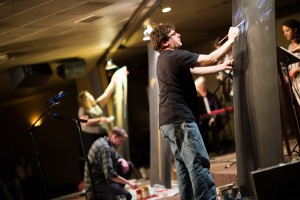
Artists from the congregation paint live during a special service. Photo: Nathan Siner/The Siners Photography. The amount of time allowed to paint will also influence the complexity of the image
- Plan and prepare like the painters in this chapter describe. Try different techniques.
- Keep painting where you have been allowed to and let God work. If you haven’t been invited to paint on the platform, just keep painting off stage until you develop more skill.
- Even when God gives you a picture to paint, you may not see the fruit of it or it may take a while for the intended recipient to connect with it. In 2010 God gave me a picture of a diver jumping off an impossibly high cliff to paint at a conference. I felt strongly that it was for someone specific, someone who God was calling to take a big leap of faith, but no one came forward that night. Nearly four years later, the painting was chosen for a community art show at church and a man immediately connected with it, saying he had to have it. He was a diving coach on a national level, and when I delivered it to him he said the God had inspired him to buy some land and start a national training center. He felt the painting confirmed his leap of faith and it would hang in their lobby as a reminder and a symbol of belief.
More thoughts on what to paint
Scott Erickson usually commits to an image before he starts painting it, building up his layers as he goes, although there have been times when God’s taught him obedience by only giving him pieces of the painting to do at a time. Tom Clark will know what the image is but he might not know the colors or exact design. Bryn Gillette is open to changing things as he goes, “There are times I go in with an image and in real time that one gets overridden by what’s happening in the service. There are times that I’m commissioned by the church with a very specific assignment and the Lord is very clear. But there are other times I’ve gone up with literally a blank canvas and I just start pushing the paint around like in the mood of the day and them imagery forms.” I usually have a solid idea of what I’m painting, will sketch it out on the canvas, and then remain open to changes and variations as I go.
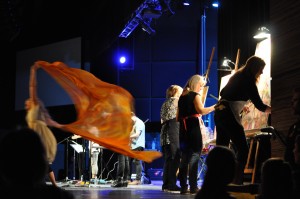
Materials needed for live painting
• Plenty of coverage protection (plastic on tables, and heavy canvas drop cloths taped onto the floor so nobody trips)
• A stable easel
• Work light on the easel
• Paints and brushes
• Water and paper towels
Paints
Acrylics are the most recommended medium for live painting. They have few drawbacks and mediums are available that can be mixed with them to dry slower or increase texture. Charcoal can be slightly messy and will need to be sprayed with fixative (some use hairspray) before transporting, chalk also needs to be fixed and can leave a large mess on the floor. Oils can be smelly and stay wet for sometimes weeks, making them hard to transport, and– if there is an accident or spill–can cause permanent marks because they are not water soluble.
Bryn’s process of painting with oils
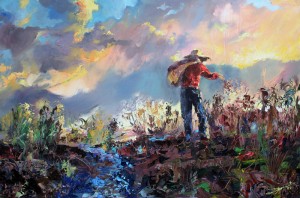
It’s worth noting that Bryn Gillette, an accomplished artist and art teacher and a platform painter at Walnut Hill Church in New Haven, Connecticut, has found ways around the problems of oils and prefers to work with them while painting at his home church. He eliminates the smell by taking turpentine out of his process. “I use an alkyd resin medium, I don’t even have actual oil. The only time I’ll take turpentine out is after the service to clean my brushes. I paint with non-latex nitrile gloves on to keep the paint off my skin. I’ve found the alkyd is the right consistency so I can just mix the pure paint right into it and there is nothing evaporating in the room, no fumes. I love the lush and strong pigments that come out of oil paints.”
When Bryn is done he’ll just stuff his brushes into the fingers of the nitrile gloves he uses and tie them off and be able to clean them later. “I paint with a palate knife a lot too. I’ll mix with it because I can keep my colors clean, and I think because of my speed a lot of my painting happens through the knife itself. You can lay the paint onto the canvas and pure color can go over top of wet other color without mixing, but then you can also scrape through it. So my materials do deeply affect my process and the final product.”
Still, when he travels it’s often back to the convenience of acrylics. He’ll just add a slow drying medium to make it act more like oil.
Pricing Paintings
There are a number of ways to price paintings. Some work better than others for pricing paintings created live.
1. How much do you want to make an hour? Some consider the amount of time it took them to paint, decide how much per hour they want to make, multiply the two, then charge accordingly. Don’t forget add in your material and travel costs. This works better for studio paintings than for live paintings since most live paintings are created in under an hour.
2. Charging per square inch. Established professional painters, especially studio painters who have a following, often calculate by dollars-per-square inch. So a 30′ x 40′ painting at $1 a square inch would be $1,200. At $3 a square inch it would be $3,600. It’s hard to imagine a painting created live during a church service ever commanding this much money, so wouldn’t be a good way to price such a painting. But it is good to be aware of.
3. Set a general standard price for your work. This is probably the best option for pricing live paintings. You may set a price for the different sizes of paintings you do, taking into consideration the price of the canvas or board you paint on.
Scott Erickson often charged $100 for the paintings he made during services at Ecclesia Church. They took him about 45 minutes to create during a service. He wanted to make them easily acquirable by anyone and he felt as paid part-time employee of the church that he should put the money made from his live paintings back into the arts ministry,
It’s suggested that even if an artist likes to give their live paintings away, they still a set value them and tell the person who receives the painting what that is. Not to make them feel bad or uncomfortable, but because its human nature to value something more highly if they know it has a significant value. A free painting may eventually end up in the trash because the artist didn’t assign a monetary value to it.
Thoughts from Bryn Gillette
Bryn Gillette identifies three attributes of a good platform painter that he thinks are interrelated.
1. Personal intimacy with Christ and the ability to hear the Holy Spirit in the moment. Bryn thinks this is born in a lifestyle of holiness, and protected by a discipline of spending regular time with the Lord.
2. Excellence of our craft. Bryn says, “For me as a painter, I want to be very well trained and to understand my equipment and material, the same way that a pastor would train at the seminary or study to really understand the nuances of the word.”
3. Integration into the body of Christ. “You need to know where you fit in the body,” Bryn says, “to be submitted to authority, transparent, and accountable to others. The Lord pours out his gifts so we can serve one another and so that the whole body is healthy and growing. During a worship service I’m functioning as a part of the body. I may be there almost as a scribe documenting what the Spirit’s doing in real time in these image formats. Almost creating artifacts or memorials to what the Lord did when he met us so it stands as a witness later when we look back.”
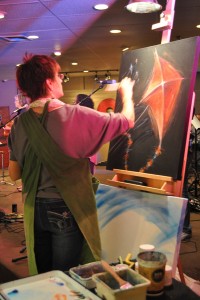
Bryn says, “I think we artists need to be humble and willing to take feedback, about both the artistic craft, and the content.
I certainly don’t know all that the Spirit’s doing through me, so when a pastor comes and says, ‘That’s a great word but it’s not for now, that’s for 2 months from now’, or ‘That’s a great word, but that’s not public, that’s meant for this specific individual’. Or, ‘That’s a great word, I think you’re missing this layer to it, like there is another meaning, I think you need to include this imagery to complete this.’ I would just say the spirit works in unique ways each time but to be flexible like that. For artists starting out in this, you can be great in your skill and intimate with the Lord and miss it, like you are trying to wing it on your own skill of being able to paint. Adversely, you can be very close with the Lord and kind of wing it because God gives you images, but then paint it really badly and I don’t think that serves the body very well either, especially if you’re not open to criticism in that regard. So develop both your intimacy with the Lord and the excellence of your craft. You cant go wrong continuing your education and training and discipleship in either of those areas.”
“On that spectrum from representational imagery to abstract, I fall more on the representational. A lot of my craft has been not figurative drawing but knowing how to draw figures even from imagination accurately. And I think that came a lot from my study with Bruce Herman. Whereas my apprenticeship with Mako Fujimura is so much more abstract that is has now come into my process, as it has to Bruce’s as well, (because of his friendship with Mako). I do feel like I’m trying to communicate more just through color and design and shape, but it’s rare that I end up leaving an image without representational anchors in it. I think that its honestly just knowing my congregation and the service to them, that I want use direct imagery because that speaks clearly and more distinctly to the group that I’m with.”
“There was a woman just recently who came up and saw a study I was doing for one of the bigger paintings, so the study had been done during one service and the bigger painting was a multi service time frame painting. The study was 2’ x3’ and the final was 4’x6’. She was in tears when she came up and it was evident that the lord was speaking to her. Before the service I felt like the Lord gave me a heads up He was saying this painting would be given away today, so watch for the person that comes up. It was just so obvious. It’s fun to see that and be able to give a good gift. She was bawling when I told her and I was bawling, too. It was just such a beautiful moment. Two weeks later when it was dry and I had cleaned it up and finished everything, I brought it in to her and she handed me a very generous amount of cash which I wasn’t expecting. She reciprocated the blessing.”
Many of Bryn’s live paintings inform each other. The color scheme from one becomes the backdrop for another. God may lead him to pull out a painting from years back that’s related to a message that He seems to be speaking now and use it for the foundation of a new painting.
“Then there are these bigger paintings I’ve been doing more recently which do evolve over many services. I feel like those are often about a season for the church and not a particular event. Those paintings are continued and reworked as new layers of what God is doing emerge.” (all quotes from an interview with the author)
Thoughts from Scott Erickson:
Scott talks about the value of preparation for the artist, “People who preach don’t get to the church and think, ‘Oh well, the Holy
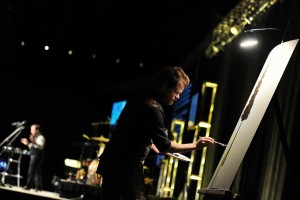
Spirit will just help me figure out this complicated 40 minute sermon’, you know? I’m not saying that doesn’t ever happen but but a worship leader usually doesn’t go, ‘The Holy Spirit will just come in and figure out this 5 piece band and all our transitions in our songs. We generally expect that those who speak from the platform in our churches have done some preparation in study and prayer and have an idea of what God would have them speak about. Then, when they apply themselves we expect that the Holy Spirit would come and add something more; that worship and preaching would be brought to life in collaboration with God. It’s the same with live painting.” (from an interview with the author)
Scott feels like the biggest misconception people have about what he does is…”That I’m just going to paint Christian imagery for Christians in their Christian churches. I’m interested in the larger discussion that’s happening in the world of art—a discussion from lots of perspectives, beliefs, and different subjects. My goal here isn’t to make Christian worship pieces, although that may happen. My goal is to create out of the stories we find ourselves in. Stories of redemption, forgiveness, cheating, murder, hope, love, poverty, suffering, doubt, sex, abuse, care, joy, and pain.
We cheapen the amazingness of the gospel when we are not honest about our human condition. This is the condition that Christ came into and lived among. What does it look like to see Christ in the midst of all these stories presently? That’s what I hope to create—whether it’s pretty or ugly, safe or dangerous, hopeful or hopeless. The best thing I can do as an artist is to be honest.”
(The proceed two paragraphs were from an interview with Margret Feinberg. http://margaretfeinberg.com/what-does-it-look-like-to-be-a-churchs-artist-in-esidence-an-interview-with-scott-erickson/#sthash.RJcLyug9.dpuf )
Scott on whether he is a prophetic artists: “People will say, ‘Oh so are you like a prophetic worship artist?’ First of all I grew up Lutheran so I don’t even have a concept for what that even means. but if you mean prophetic as in it’s revealing; it’s revealing God and it’s turning us back to him and it’s revealing something about God and it’s based in his word, then yeah. And if worship is responding to God, then I feel like there is interaction. So yes i guess that’s it. When I was at at Ecclesia.–a very non-denominational church with some Baptist–nothing very charismatic is going on there. But I would say it was for sure the Holy Spirit working there. Every single weekend things were put together in a way that we would never have any control over and it was amazing to just witness it. (From an interview with the author.)
On explaining his paintings: Scott’s opinion is that most of his paintings should speak for themselves. He is open to explaining paintings from the stage in churches where painting is new, but he believes he is communicating in a visual language, so words generally are not needed.
Scott paints live on wood panels. “I actually like painting on panel or wood much better than canvas.”
“We don’t build rock monuments anymore but what if we add art, visual art created about something (happening in the church), and then we can remember it every time we saw it?”
On the joy of painting live: “You’re right in the middle of everything spiritually and physically and a natural gratefulness may fill you, to be privileged to serve your congregation and collaborate with God in this way.” (from an Interview with the author.)

Thoughts from Tom Clark:
Tom Clark is a genial California artist with a penchant for painting barefoot. He doesn’t like to repeat paintings, “That kind of goes against my nature. I just don’t like to do anything twice. Plus, I think it feels like I’m not really responding, so for me it’s a challenge. It’s trying to create imagery with some sort of symbolism that says what should be said but done in a way that it’s not so obvious. It’s kind of like Jesus with the parables. I think what I paint is symbolic and people will kind of go, “What were you trying to say there?” And then they kind of go, “Oh,yeah!” Or they kind of get their own symbolism out of it, which is the coolest thing. They might say, “I see what you’re trying to say and they will say what they think and I’ll kind of go “cool.” So that’s why I don’t like to talk too much about it, I just kind of let it happen. That way people can get out of it what they want. So there’s this whole allegory kind of psalms thing going on of, I think where everybody gets something different out of it.
“When I do a live painting, ill have a sketch, but I don’t know exactly what Im going to do, I don’t know the color. It allows for more freedom in the spirit. Wherever I’m going I ask what they are speaking on , what scripture. Ill get some ideas and sketch some things out. I might have a sketch because I can be up there thinking about what im going to do,. Sometimes its 15 mins, sometimes 45. So I got that in my head and the more you do the more you get good at it and im thinking about what people are seeing. Im 2 ft away and they are sometimes 100 ft away. You learn to paint so it reads well for the audience.
Sometimes I use stencils and things. I never want to get stuck in the process of how I do it, so I’m always experimenting. Sometimes its really good, sometimes its not so great. Sometimes when a think its not great, then someone will come up and go, ‘That is the most amazing thing Ive ever…’
I’ve done a lot of life drawing and I’m always better with the quicker stuff, so when people are telling me, ‘Hey were gonna give you all this time’, I go, ‘You know what, don’t give me that much time, I don’t really need that much time’. You have to loose a love of your work, because its not about the finished product, but the process. People seeing something transformed before them. Sometimes Ill have some fun where Ill kind of reveal things, but I try not to be too gimmicky I try to be more about the process of painting. I don’t want to put some paint on a flip the canvas around. That’s fine but to me its more of a magic trick. I want the audience to be encouraged by the process, especially the artists, to see that its doable.” (From an interview with the author.)
More on Art Tables from Jessie Nilo:
Art tables are a bit different from personal prophetic art stations where an artist draws something for you in prayer. This is instead
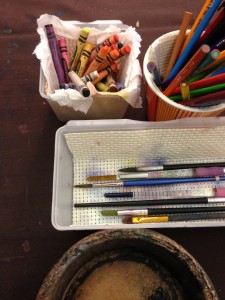
making a physical space for visual learners to create small, simple artwork as a personal response to God during a Sunday service. In addition to the standard rows of pews or chairs, a few tables are provided with art supplies for anyone would like to use the art table area.
The idea is to invite your congregation to come over and experiment with using simple things like colored pencils and watercolor kits in order to visually process what they’re learning in church. It’s a quiet area where they can hear and respond to God through color and line, and write out what God is doing in their hearts.
Our art tables are open from the beginning to the end of our service—during worship, the reading of God’s Word, and even during the pastor’s message. People create things on a small, personal scale (no easels) and everything remains between Jesus and the person who is drawing/coloring/painting/writing. Nobody looks over anyone’s shoulder. Our visual learners appreciate being able to quietly take notes, scribble, doodle, and create, while honoring the many auditory learners surrounding us in the room. (Sssshhhh; honor the silence; more about our signs below.)
For two years we’ve provided 3 tables during our Sunday morning services, but we didn’t know how long we’d let them stay when we started. This fantastic experiment began when our media pastor and senior pastor were planning a special service for the beginning of the year, a special reading of scripture with times of reflection built in. They wanted to invite people in their contemplation to go to the edges of the room to receive prayer, or sit in silent meditation in their seat, or go to an art table section to draw or paint whatever God revealed to that person in their heart. The pastors asked if I could set up and facilitate the art table section, and I happily said yes. Was I dreaming? Was this really happening? I hoped the congregation would respond.
We brought in three folding six-foot tables and set them apart from each other along the side wall of the sanctuary, taking egress codes into account. We chose the side of the room because it’s close to our kitchen (water supply) and we didn’t want the art tables to feel relegated to the back of the sanctuary, nor did we want it to feel too scary to approach in front. Of course this project meant clearing out a few rows of chairs. We replaced 30 chairs with 3 tables and 15 chairs, 5 chairs per table (no chair on the end with someone’s back to the stage). Where before we had 30 chairs, we now had 15. But the fruits we’ve seen from this art section have been well worth the cost of a few chairs.
Our pastor’s message that morning was powerful and at least a dozen people used the tables each service to reflect. The following week, our media director asked if we could leave the tables up for a while longer. Our pastor, not knowing how long we should leave them up, tentatively agreed to leave them up for a few more weeks, and we could see what happened. I agreed. We don’t treat an experiment as if it’s permanent before it’s deemed valuable by our culture. Besides, there is great freedom in being able to quietly remove something two weeks or six months from now when you decide its time is up. But gradually the tables became a semi-permanent fixture in our sanctuary. People grew accustomed to them, and we didn’t act like they’d be there forever; they just were available.
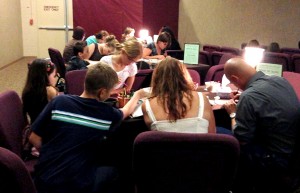
At first we taped canvas drop cloths to the carpet underneath the tables to communicate that we were trying our best to respect our sanctuary as a shared space. But eventually I realized that since we only use watercolors and pastels, drop cloths underneath were overkill, so with the pastors’ permission we went back to having unprotected carpet underneath, which looked a whole lot nicer. At this time I quietly removed the soft pastels, replacing them with crayons which are far less messy. We don’t have to deal with powdery messes left around the edges of papers anymore. We also got rid of collaging materials and scissors, simplifying and storing only the most basic supplies and paper in a burgundy basket on one end of each table. Maintenance now consists of replacing watercolor kits as they’re used up, sharpening the colored pencils and regular pencils maybe twice a month, and emptying the small hand-held pencil sharpener on each table.
One of the first things that made me cringe were the noises that came not from conversations, but from the hands of the people using the art tables. People would casually drop their colored pencil onto the surface of the plastic table—clink! People would tap watercolor brushes on the edge of the water container—tap tap tap! And people would wrinkle, fold, and crinkle the thin white paper, not realizing they were even making noise. Even the plastic chairs got in on the ruckus, clanking into the backs of the chair behind them as people rose to leave. It probably wasn’t really that loud, but in a quiet sanctuary filled with people trying to concentrate on the sermon, it was distracting.
So I went to the store and bought padded outdoor tablecloths, the vinyl kind lined with soft fleece on the underside, and that alone reduced the table noise by 90%. I also lined the top of the water containers with foam strips of insulation so that when people tap their brushes, it makes no noise. And we bought nice, thick card stock with a slight watercolor paper texture that feels almost like cloth, which solves the noise problem of any paper folding or wrinkling. We also bring each ream of paper to an office supply store and ask them to cut the whole ream into fourths for us, which not only extends our paper supply, but creates less of a tendency to fold because the paper is so small to begin with.
Over time, our art table area has become more aesthetically beautiful. We bought dark linens to cover the tables, placing them right on top of the padded noise-canceling vinyl tablecloths. We also added beautiful table lamps to each table, illuminating the area even when the overhead lights are dimmed for worship. We surrounded each table with cushioned sanctuary chairs rather than plastic folding chairs, which eliminated the noises of plastic chairs clanking against each other. I recommend keeping water containers a bit separated from table lamps because of electricity. Twisting the lamp’s cord around a table leg a few times will ensure nobody will trip and break the lamp. Also, taping extension cords onto the floor with acid-free Gaff tape will prevent tripping on the cords.
The signs on our tables say:
“Art Tables: Please honor the silence. For ages 14 and up only. We invite you to make things in quiet contemplation during worship
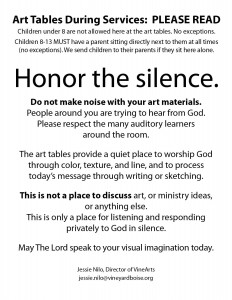
and today’s message. Please respect the auditory learners around you as you process God’s Word through visual contemplation.” There is also a small sign on our paper basket saying, “Please only use two sheets of paper per person.”
There are three of us on the art team who take turns preparing the tables and keeping an eye on people there during the service. We hardly need to do anything. Many artists bring along their own supplies to use at the tables, such as favorite watercolor sets, sketchbooks, pastels, and journals.
Note: VineArts intentionally holds kids’ classes to teach how God lets us see pictures in our minds. They affirm and validate cartooning as a form of art while teaching that time at the art tables is different from practicing how to draw. Holding these classes drastically cuts down the number of half-drawn Pokémon characters they find at their art tables; but you will always have people who need grace and patience, because not everyone understands. Be patient as God is patient, and don’t ever jump down someone’s throat for drawing the “wrong thing” in church.
For extended times of worship when there’s not a verbal message, you might try not putting chairs around the art tables. Not offering chairs ensures they won’t be too comfortable or territorial before leaving to worship in another part of the room, and gives many more people the chance to experience the tables. This can encourage people to come over to draw and paint, then leave after a few minutes so someone else can experience it too. Some leave their artwork behind as part of their act of worship, while others take it with them.
Sometimes a pastor’s biblical imagery and passion will inspire the artists of Vineyard Boise to erupt in sketchbooks wherever they’re sitting around the sanctuary; later that day the congregation can see what was going on in their artists’ minds as posts of artwork go up on blogs and Facebook pages, surrounded by the artist’s unique notes, scribbles, and artwork proclaiming the power and goodness of God.
The idea is to invite the congregation to come over and use things like colored pencils and watercolor kits as they express worship and process what they’re learning in church. Our art tables are open from the beginning to the end of our service—starting with worship, through the reading of God’s Word, and during the pastor’s message. People create on a small, personal scale (no easels) and everything remains between Jesus and the person who is drawing/painting/writing. We appreciate being able to quietly take notes, doodle, and create, while honoring the many auditory learners around us.
Providing a space to draw in church gives artists a kind of permission they rarely encounter. One artist, John, was a New Age seeker who loved hanging out with the artists of VineArts. He would have coffee with us in our lobby but held back from entering the sanctuary when the rest of us went inside. He explained that he knew he wasn’t supposed to draw in church. This was heartbreaking, because if something was meaningful to John, he needed to draw it on the spot. Only after we explained that we regularly draw in church ourselves did John feel that he and his learning style were welcome in our sanctuary. I imagine Jesus wouldn’t mind if someone took out a sketchbook while he was telling a parable.
Younger Children
We have found it very necessary to enforce an age requirement, because this area is designed for adults and teens processing deeply spiritual content. When we stopped setting clear age requirements and communicating the purpose of the art tables, it quickly dissolved into a never-ending baby-sitting gig for our art team, and it drove us crazy. Art materials attract bored 12-year-olds who draw Spider-Man over and over, and fussy 6-year-olds with no parent in sight who make a ruckus when they can’t find the red crayon.
During regular church services we have a stack of small fliers on the art tables saying: “Please sit with your child at the art tables if they’re under age 14.” And we give that slip of paper to any child we find by themselves at the art table. Kindly yet firmly, we whisper to the solitary child: “Go give this note to your mom or dad, and ask them to come back and sit here with you if you want to stay.” No exceptions.
But now we are moving to a different model because our Sunday school director is adding art tables to their Sunday school worship room, so we’re thinking of making the art tables for ages 14 and up, with no exceptions. But we’ll see how it goes; I have a soft spot in my heart for kids who truly want to worship God through visual methods… even kids who skip Sunday School for whatever reason.
Sunday School Kids at Art Tables
A couple of people on my art team are gifted at talking with children about subjects like worship and visual processing, so once in a while we visit their Sunday school classrooms and offer visual artmaking materials while they worship. We teach the children that our imaginations are wonderful and that we can ask God to give us pictures inside our minds, as well as draw things for God as an expression of how much we love him.
Having a degree in illustration, I take this opportunity to affirm and validate cartooning while teaching originality in expression. I tell the kids: “I love drawing cartoons, and I learn so much from copying illustrations of artists who have come before me, like some of you enjoy drawing Pokémon and Catbug. But our time at the art tables is different from practicing how to draw. Spending time with God in your art is really not about copying Steve Ditko and drawing Spider-Man. That’s getting inside of Steve Ditko’s head. When I worship God, I want to get into God’s imagination, not the head of another artist. What new thing does God want me to draw today?” Then we all practice listening to God as we draw and create on paper.
This drastically cuts down on the number of half-drawn Pokémon cartoons that I find at our art tables; but please understand that you will always have some kids who need grace and patience, because they don’t get it yet. Love them through their art regardless of whether they understand. I will always err on the side of grace and patience. We must never jump down a kid’s throat for drawing the “wrong thing” in church. You and I are not called to be judges of how other people best relate to Jesus through their art, and this includes kids. Never hinder or shame a child in their art, especially pompously in the name of God and his Church.
Variation: Extended Worship
I don’t bother to put any chairs around art tables when we set up a night of worship, especially for extended nights of worship with teenagers. Being quiet is not normally an issue, unless a verbal message is given. We always bring out the watercolor sets and yes, our gloriously messy soft pastels! If it’s to be a long worship set, I want to create a spontaneous flow with a large turnover of kids coming over to draw and paint, and then leaving again to worship in another part of the room, making room for someone else to come and draw or paint. We’ve facilitated art tables for several hours at a time with teenagers, some kids kneeling, most standing, as they create with God in the lamp light. I actually don’t want them to be too comfortable (or territorial) in chairs in hopes they will go and experience God in another part of the room as well.
Kids often leave their drawings behind as a sort of offering to The Lord, but some choose to take their drawing home with them. Some even leave behind their artwork with a message intended to inspire someone else. Words of encouragement and scripture permeate their art.
Our art team is busy on those nights taking buckets back and forth from the art tables: one bucket to pour dirty paint water into, plus a bucket of clean water to dunk the empty containers into to fill them. We also monitor the paper supply and we collect the abandoned art as it piles up, bringing it over to another table to dry; and sometimes we hang up their artwork with tiny clothespins stretched across a long string on the walls as it dries.
Re-Visit the Purpose
Remember to uphold your original vision for everything you offer through the arts. If a certain ministry area is being jeopardized or misused, ask yourself in what ways it’s being pulled away from the original intent. For instance, if we see someone of any age who is distracting others due to conversation volume or the type of artwork they’re making, we quietly and kindly explain the purpose of this area. If they still don’t act very receptive to us, we spell it out and ask that person to not use the art tables to distract others. But sometimes it’s a brand new person. Or there may be an intense spiritual battle raging inside of them. Always err on the side of grace.
Art tables during the service are not a place to discuss things—not even good things like art, exciting ministry ideas, or even prophecy, all of which can wait until after the service. Prayer is the one exception I’ll make; how can I stop someone from quietly praying with another person, when they feel led? But our first priority is to preserve the freedom for creative thinkers to pour out their imaginations in a one-on-one encounter with The Lord.
Art Table Benefits
by Jessie Nilo
Providing such an individual and safe experience makes it hard to research or quantify the benefits of having art tables in the sanctuary, but I’ll give it a try.
During a given service, I see different ages, abilities, and genders using the tables. Our average is a dozen people each service, of whom I notice maybe one or two professional artist friends who don’t serve on the art ministry team at church; another one or two artists from my VineArts leadership team; and the rest of the dozen people are a random cross-section of the population of our congregation, consisting of creatives as well as regular folks, some of whom I know and some of whom I don’t, mostly adults, with a child or two mixed in. It’s not the same group of people who use the art tables each Sunday.
Several parents of shy children who don’t do well in Sunday School have come up to me, thanking me and saying their child loves coming to church and drawing pictures for God. Well, honestly I’d rather see them go to Sunday School, but I’m glad their parent sits right next to them so their child can experience the art tables. I’m blown away by the thought of a child who knows that God loves his or her art, and loves coming to church to draw. The parents of a twelve-year-old boy told me that their son had never understood sermons until he started drawing them at our art tables, and now I often see him sitting at the tables with his dad, quietly drawing what he hears and then showing it to his parents right after church.
I usually see one of our artist “regulars” at the art tables with her professional markers and watercolors illustrating the sermon in her journal as she listens. (I always want to peek closer at her journal, but I resist!) I usually draw and paint sermon notes too, using my portable watercolors and black pigma pens in my Moleskine sketchbook. Jotting down and illustrating whatever strikes me helps me to grasp God’s Word in a much deeper way than just listening.
Providing a dedicated space to create in church also legalizes drawing in church in general, wherever people might be sitting in the rows or pews. An artist friend of mine, John, was an honest New Age seeker who loved hanging out with the artists of our church. He would hang out in the lobby with us over coffee, but he always held back from entering the sanctuary when the rest of us went inside. Why? Because if something held meaning for John, he needed to draw it, and he knew people weren’t supposed to draw in church; he told me he was afraid that people would think him rude. I responded, “Not in this church.” So he worked up the courage to enter the sanctuary on the following Sunday and I sat next to my friend, both of us drawing in our sketchbooks during the sermon.
I’ll never forget the Sunday Pastor Mike took the stage and gave a booming sermon about the day the sun stood still, passionately urging us with swooping arms to never box God into “reasonable explanations.” His biblical imagery inspired all the artists in the church to erupt in their sketchbooks wherever they sat around the sanctuary; later that afternoon, portraits of Mike preaching were going up on our artists’ Facebook pages, each portrait drawn from a different angle and surrounded by the artist’s unique notes, scribbles, and artwork proclaiming the power of God: everyone’s individual take on the same sermon.
I’ve had adults approach me in tears, saying they never knew God cared about creativity until they discovered our art tables. One artist, Corinna Stevens, visited our church because she saw on our web site that we had “art tables.” Heart pounding, she wondered what that could mean. She hadn’t been inside a church in four years after leaving her last church which was abusive and controlling. When she entered our sanctuary, she immediately felt at home. “I remember seeing the art tables in the sanctuary for the first time, and I was absolutely amazed that something like this existed! How could that be? And yet… there they were! I sat in the back at first, but during that service I moved several times, closer and closer to the art tables… and finally I sat at one of them and started to draw. I don’t recall what I created that day, but what I felt was the Spirit of God moving in my heart.” Hungry for more of God, Corinna jumped into VineArts full speed. Only a year later, Jessie made her a VineArts leader. Corinna now tells others, “If you’ve ever thought about making your way over to the art tables during service, I encourage you to be strong and bold and just do it; you might find it is right where you belong!”
Another VineArts leader, Dottie, sat ready to create while waiting for the service to start, back when the art tables were new to us. She prayed that God would bless what she would create. Suddenly a detailed nature scene came into her mind, and words that accompanied it. She painted it while listening to the sermon, feeling a growing sensation that it was for someone else. After church she asked the Lord what she was to do with the painting, and she heard God say, “Amber.” But seeing no one named Amber, she put it in her purse and went home. She wondered if it was really God or just her own thoughts.
Three weeks later, she prayed again before heading into a store. Once inside, she saw a beautiful transparent wastebasket and lifted it up for the price, and there on the tag she read: Amber. Just then she heard a man’s voice say, “Hey Amber, you gotta come see this!” Dottie slowly turned her cart and prayers directly toward wherever God wanted her. Shakily she reached into her purse, approached Amber, and with rookie words, quickly told her about the process of making the piece, suggesting that she pray about it. Amber took it and thanked her with pink cheeks, all the while hungrily taking in what she saw with large eyes. She thanked Dottie again and they parted ways.
Ten minutes later, the woman came back into the store, found Dottie, and said, “Excuse me, but I think I know what this means; can you tell me what you think it means?” Dottie told Amber her impression of its meaning, and the woman’s eyes filled with tears. Nodding, she said, “Yes. I thought that’s what it meant.” She walked out, and Dottie never saw the woman again. That was two years ago.
Now, before Dottie sits down at the art tables on Sundays, she prays to be used of God. She says, “The Holy Spirit has given me many words and pictures for people over the past two years. I ask him what colors to use, what shapes, and so on. More than once, he has led me to draw a person without me knowing who will receive it later, and it looks just like them! I hope with each new level God brings me into, that I’m hearing from him while I wait to see his pictures.”
“In a recent VineArts Gallery installment, there was a painting of Jesus’ scarred hands holding a crown. My two-year-old was fascinated, first by the glittery crown, but then by the hands. She asked whose hands they were and why they had an “owie.” My husband and I explained (in two-year-old terms) that Jesus had to have the owies for us to be forgiven for the bad things we do. “Why him not wear the sparkly crown?” she asked next. We told her that Jesus would be coming again, and then we would see him wearing his crown. I wasn’t sure how much she took in that day, but every time we passed that painting (several times a day!) she’d stop and stare long and hard at it. A few weeks later, she asked Jesus to be in her heart. That painting did more for her understanding what Jesus did for her then my words could. Even if it wasn’t the message the artist was going for, the Holy Spirit moved in her in a very relevant and personal way.” Rachel Freeman
From a very young age, Juliette has processed her feelings through art. When she comes into service with me, we sit at the art tables. (Since she’s 5, she sits on my lap.) The art she creates astounds me! I know she’s hearing the Word being taught. I see the Holy Spirit working through her drawings.
I know she’s not to the point of using the tables to bless others with prophetic art, but I see growth happening and her moving in that direction. She is blessed by the art tables. And I am blessed knowing she has a safe place to worship in the way God created her.
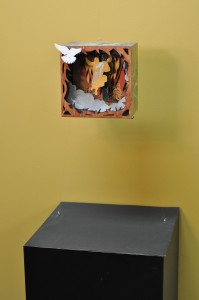
Art in the prayer room:
(From http://smvineyard.org/main/?page_id=288 )
Why do we encourage creativity in the prayer room?
Prayer is about partnership with God. We dialogue…we share our heart, and He shares His. We serve a Creative God, and He speaks to us in creative ways. So, we have established the prayer room to include different visual aids and stations to help facilitate intimacy with God. Prayer stations can help us to focus on different themes that the Lord may direct us to as a church body. We are a visually stimulated generation so prayer stations help to be an inspiration to all. We believe that we can learn from each other, and stir up passion for the Lord, which in turn fuels passion for the lost.
Poetry
Poetry can teach us to infuse life with beauty and meaning. A challenge in modern management can be to keep ourselves and our colleagues invested with wonder and purpose. As Simon Sinek and others have documented, the best companies and people never lose a sense of why they do what they do. Neither do poets. In her Nobel lecture “The Poet and the World,” Wislawa Szymborska writes:
The world — whatever we might think when terrified by its vastness and our own impotence … is astonishing …
Granted, in daily speech, where we don’t stop to consider every word, we all use phrases like “the ordinary world,” “ordinary life,” “the ordinary course of events” … But in the language of poetry, where every word is weighed, nothing is usual or normal. Not a single stone and not a single cloud above it. Not a single day and not a single night after it. And above all, not a single existence, not anyone’s existence in this world.
(From, The Harvard Business Review, The Benefits of Poetry for the Professional by John Coleman https://hbr.org/2012/11/the-benefits-of-poetry-for-pro )
Poetry has been well defined as “the measured language of emotion.” Hebrew poetry deals almost exclusively with the great question of man’s relation to God. “Guilt, condemnation, punishment, pardon, redemption, repentance are the awful themes of this heaven-born poetry.” In the Hebrew scriptures there are found three distinct kinds of poetry, (1) that of the Book of Job and the Song of Solomon, which is dramatic; (2) that of the Book of Psalms, which is lyrical; and (3) that of the Book of Ecclesiastes, which is didactic and sententious. Hebrew poetry has nothing akin to that of Western nations. It has neither meter nor rhyme. Its great

peculiarity consists in the mutual correspondence of sentences or clauses,
poetry. (n.dPoetry Shows the World In a New Light
One of the tasks that a good poet is trying to accomplish is that they want you to see some aspect of the world in a new light. They can give you an unusual turn of phrase or image that focuses your attention on something in a completely new way. Commonplace objects and events take on a new meaning when tackled by poets.
The Poets Corner is not the only place where poetry can be found in the Cathedral Church of St. John the Divine. In 1976, poet Muriel Rukeyser founded The Poetry Wall in the ambulatory of the Cathedral as a place where poems will always be accepted. Rukeyser explained “the whole idea is openness, a free giving and accepting of poetry. Poets meet so many rejections in their work. This is the place where poems will always be accepted. They can be signed or unsigned and in all languages.” Poems can be sent to: The Muriel Rukeyser Poetry Wall, The Cathedral Church of St John the Divine, 1047 Amsterdam Avenue, New York, NY 10025. – See more at: http://www.poets.org/viewmedia.php/prmMID/5742#sthash.lNRMt7oF.dpuf
